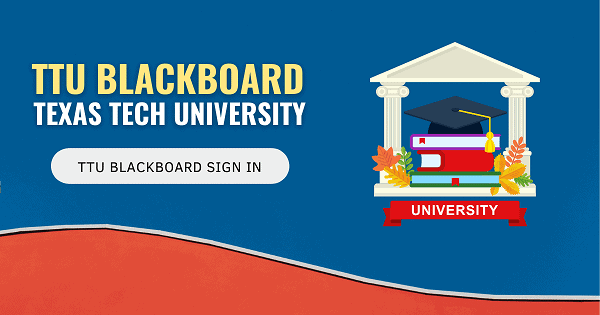TTU Blackboard Step into the world of digital learning, where education meets innovation. Welcome to the evolution of e-learning and the remarkable features of TTU Blackboard! This blog post will deeply dive into the history, present state, and future possibilities of this groundbreaking platform that has revolutionized how students learn online. But before we delve into all that TTU Blackboard offers, let’s first explore what e-learning is and its journey thus far. So grab your virtual backpacks and get ready for an enlightening adventure through the realm of online education!
Blackboard: The E-Learning Platform
Blackboard: The E-Learning Platform
TTU Blackboard In the ever-evolving world of education, Blackboard has emerged as a formidable player in e-learning. Its user-friendly interface and innovative features offer students and educators a dynamic virtual environment for teaching and learning.TTU Blackboard
At its core, Blackboard is an online platform that seamlessly integrates various tools and resources to create a comprehensive digital classroom. It is a centralized hub where instructors can deliver course materials, facilitate discussions, assess student progress, and provide valuable feedback.TTU Blackboard
One of the critical strengths of Blackboard lies in its versatility. Whether enrolled in a traditional brick-and-mortar institution or pursuing an online degree program, this platform adapts to your educational needs. It provides access to course content anytime and anywhere, enabling students to learn at their own pace while juggling other commitments.TTU Blackboard
Collaboration lies at the heart of practical learning experiences. With Blackboard’s collaborative tools, such as discussion boards and group projects, students can engage with their peers virtually – exchanging ideas, asking questions, and fostering meaningful connections beyond physical boundaries.TTU Blackboard
Furthermore, Blackboard boasts interactive features that elevate the learning experience. From multimedia integration to virtual simulations or gamification elements – these tools stimulate student engagement by making lessons more immersive and enjoyable.TTU Blackboard
As technology advances rapidly year after year, so does Blackboard’s functionality. The platform continuously evolves to incorporate cutting-edge innovations like mobile accessibility on smartphones or tablets, ensuring seamless navigation for learners always on the go.TTU Blackboard
Blackboard has undoubtedly revolutionized e-learning by providing institutions worldwide with an all-in-one solution for delivering quality education remotely. Its adaptability empowers educators and students alike to embrace new possibilities within this ever-expanding digital landscape.TTU Blackboard
The History of Blackboard
The history of Blackboard is a fascinating journey that showcases the evolution of e-learning platforms. It all started in 1997 when two graduate students, Matthew Pittinsky and Michael Chasen, founded Blackboard Inc. to revolutionize education through technology.TTU Blackboard
In its early days, Blackboard was primarily focused on providing course management systems for universities and colleges. These systems allowed educators to create online courses, manage assignments, and facilitate student communication.TTU Blackboard
Over time, Blackboard has increased and expanded its offerings to include various tools and features that enhance the learning experience. They introduced discussion forums, online quizzes, grade books, and even virtual classrooms where students could interact in real time.
In 2011, Blackboard launched its mobile app, making accessing course materials on the go much more convenient for students and instructors. This marked a significant milestone in making e-learning accessible anytime and anywhere.TTU Blackboard
Today, Blackboard continues to be one of the leading e-learning platforms used by educational institutions worldwide. With continuous updates and improvements based on user feedback, it remains at the forefront of innovation in digital education.TTU Blackboard
As we move into the future of e-learning technologies, it will be interesting to see how Blackboard evolves further to meet the changing needs of learners and educators alike. In an increasingly digital world where remote learning has become essential due to unforeseen circumstances like pandemics or travel restrictions, platforms like TTU Blackboards are likely to play a prominent role in shaping our educational experiences for years to comeTTU Blackboard
Blackboard Today
Blackboard Today
Blackboard has evolved into a robust and versatile e-learning platform in today’s fast-paced digital world. Its user-friendly interface and extensive features make it an indispensable tool for educators and students.
One of the critical strengths of Blackboard is its ability to facilitate seamless communication between instructors and learners. Through discussion boards, messaging systems, and virtual classrooms, students can engage in meaningful discussions with their peers and receive timely feedback from their instructors.
Moreover, Blackboard offers many multimedia tools that enhance the learning experience. From interactive quizzes to video lectures, students can access dynamic content that caters to different learning styles. This keeps them engaged and promotes active participation in the learning process.TTU Blackboard
Another notable feature of Blackboard is its comprehensive assessment capabilities. Instructors can create online assessments such as quizzes or exams automatically graded by the system. This saves time for both instructors and students while providing immediate feedback on performance.TTU Blackboard
Furthermore, Blackboard provides a centralized hub where course materials are organized in an easily accessible manner. Students can find lecture notes, assignments, readings, and other resources all in one place. This ensures they have everything they need to succeed at their fingertips.TTU Blackboard
Additionally, Blackboard offers mobile compatibility through its app version. This means users can access their courses on the go using smartphones or tablets without hassle.TTU Blackboard
With its modern features tailored for compelling e-learning experiences and ease-of-use interface adaptability across multiple devices – TTU Blackboard remains at the forefront of online education platforms.TTU Blackboard
The Future of Blackboard
The Future of Blackboard
As technology advances at an unprecedented rate, the future of e-learning platforms like Blackboard is exciting and full of possibilities. Each year, innovations are being introduced, revolutionizing how we learn and interact online.
One key aspect that will shape the future of Blackboard is artificial intelligence (AI). Imagine having a virtual tutor who can analyze your learning patterns and tailor personalized lessons. AI-powered chatbots could also provide instant support and guidance to students whenever needed.
Another area where we can expect significant developments in the future is virtual reality (VR) and augmented reality (AR). These immersive technologies have already started making their way into education, allowing students to explore complex concepts through interactive simulations and virtual environments. In the coming years, integrating VR/AR capabilities into Blackboard could take online learning to a new level.
Furthermore, mobile learning will become increasingly important as mobile devices become more powerful and ubiquitous. The future version of Blackboard may be optimized for seamless access on smartphones and tablets, empowering learners to engage with course materials anytime, anywhere.
Additionally, advancements in data analytics will play a crucial role in enhancing the effectiveness of e-learning platforms like Blackboard. Educators can gain valuable insights into individual student needs and preferences by analyzing vast amounts of student data gathered from various sources, such as assessments and interactions within the forum. This data-driven approach will enable instructors to deliver targeted interventions that maximize student success.
In conclusion,
The future holds immense potential for e-learning platforms like TTU Blackboard. As technology evolves rapidly, we can anticipate exciting enhancements such as AI-powered personalization features, VR/AR integration for immersive experiences, seamless mobile access options, and advanced data analytics tools.
These developments have the power not only to transform how we learn but also ensure that education becomes more accessible, effective, and engaging than ever before
What is E-Learning?
What is E-Learning?
In today’s digital era, traditional classrooms are no longer the only option for learning. Enter e-learning, a revolutionary way of acquiring knowledge and skills through electronic resources. But what exactly is e-learning? Simply put, it refers to any form of learning online or through digital platforms.
E-learning has gained tremendous popularity recently due to its convenience and flexibility. Whether you’re a busy professional looking to enhance your skills or a student seeking additional resources outside the classroom, e-learning offers endless possibilities.
One of the critical advantages of e-learning is its accessibility. With just an internet connection and a device like a laptop or smartphone, learners can access educational content anytime and anywhere. This means no more commuting or rigid schedules – you can learn at your own pace and in your preferred environment.
Another advantage is the variety of options available in e-learning. From interactive multimedia modules to virtual reality simulations, there are countless ways to engage with course materials and make learning more engaging and enjoyable.
However, despite its many benefits, e-learning also has some drawbacks. For instance, some individuals may need more self-discipline when managing their time effectively without direct supervision. Not all subjects or skill sets can be effectively taught through online platforms alone.
E-learning has undoubtedly transformed education by breaking down geographical barriers and creating opportunities for lifelong learning. So whether you’re interested in expanding your knowledge base or exploring new areas of expertise, embrace the world of e-learning – where knowledge knows no bounds!
A Brief History of E-Learning
A Brief History of E-Learning
E-learning, or electronic learning, has come a long way since its inception. It all started in the 1960s when researchers began experimenting with computer-based training programs. These early systems were primitive compared to what we have today, but they laid the foundation for the future of online education.
In the 1980s and 1990s, as computers became more accessible and affordable, e-learning started gaining traction. Universities and corporations began using computer-based training programs to deliver educational content to their students and employees. However, these early systems were still limited by technology constraints.
The turn of the century marked a significant shift in e-learning by introducing Learning Management Systems (LMS) like Blackboard. This allowed educators to create online courses and manage student progress more efficiently. As internet speeds improved and multimedia capabilities expanded, e-learning platforms became more interactive and engaging.
Today, e-learning is integral to education at all levels – from K-12 schools to universities and beyond. With technological advancements, such as mobile devices and virtual reality, learners can access various resources anytime, anywhere.
As we look towards the future of e-learning, it’s clear that this mode of education will continue to evolve alongside technological advancements. The potential for personalized learning experiences tailored to individual needs is immense.
E-learning has opened up new opportunities for individuals who may not have access to traditional educational settings due to geographical limitations or other constraints. It has also revolutionized workplace training by providing cost-effective solutions that can be easily scaled across organizations.
In conclusion,
Constant innovation driven by technological advances characterizes the history of e-learning. From its humble beginnings as computer-based training programs to today’s sophisticated Learning Management Systems like TTU Blackboard,
e-learning has transformed how we learn and teach.
And with ongoing developments on the horizon,
The future of e-learning looks brighter than ever.
The Different Types of E-Learning
E-learning has come a long way since its inception, and today, various types of e-learning methods cater to different learning preferences and needs. Let’s dive into some of the different kinds of e-learning available.
1. Synchronous Learning: This type of e-learning refers to real-time learning where instructors and learners interact simultaneously. It can involve live webinars, virtual classrooms, or video conferencing sessions.
2. Asynchronous Learning: Unlike synchronous learning, asynchronous learning allows students to access course materials at their own pace and convenience. This type often includes pre-recorded lectures, discussion boards, email communication with instructors, and self-paced modules.
3. Blended Learning: Blended learning combines online and traditional classroom elements. It offers flexibility by combining face-to-face instruction with digital resources like videos, quizzes, or interactive modules.
4. Mobile Learning: With the rise in smartphone usage worldwide, mobile learning has gained popularity. Learners can access educational content on their mobile devices anytime and anywhere through apps or responsive websites designed for smaller screens.
5. Gamification involves incorporating game-like elements into the learning process to engage learners and enhance motivation. It uses features like badges, leaderboards, and rewards systems to make education more enjoyable.
6.
Virtual Reality (VR) & Augmented Reality (AR): These emerging technologies have revolutionized e-learning by providing immersive experiences for learners through simulated environments or overlaying digital information in real-world settings.
Each type of e-learning offers unique benefits depending on individual preferences and circumstances.
The Advantages of E-Learning
The Advantages of E-Learning
E-learning has become increasingly popular in recent years, and it’s not hard to see why. Numerous advantages come with this innovative approach to education.
One of the main benefits of e-learning is flexibility. With traditional classroom-based learning, set schedules and locations often restrict students. However, with e-learning platforms like TTU Blackboard, learners can study at their own pace and from anywhere they choose. This means you can fit your coursework around commitments such as work or family responsibilities.
Another advantage is accessibility. E-learning opens up opportunities for individuals facing barriers to traditional education, such as those with physical disabilities or those living in remote areas without easy access to educational institutions. Anyone can access online courses and educational resources with just an internet connection.
Furthermore, e-learning promotes self-paced learning. In a traditional classroom setting, students must keep up with the pace their teachers and classmates set. This can be challenging for some learners who need more time to grasp concepts or prefer a faster learning rate. In contrast, e-learning allows individuals to learn quickly, ensuring comprehension before moving on.
Additionally, e-learning offers many multimedia options that enhance engagement and understanding. Online courses often include videos, interactive quizzes, simulations, and other interactive elements that cater to different learning styles and make the material more engaging and memorable.
Last but certainly not least important is a cost-saving aspect of e-learning compared to traditional forms of education – no commuting costs or expenses related to textbooks since most materials are available online.
In conclusion,
e-learning brings many advantages, including flexibility,
accessibility,
self-paced learning,
engaging multimedia options
and significant cost savings.
These benefits make it an attractive option for both students seeking further education
and professionals looking for continued professional development.
With platforms like TTU Blackboard leading the way,
The future of e-learning looks bright and promising.
The Disadvantages of E-Learning
The Disadvantages of E-Learning:
While e-learning has gained popularity in recent years, it is essential to acknowledge some disadvantages to this mode of education. One major drawback is the need for face-to-face interaction between students and instructors. In a traditional classroom setting, students can ask questions and engage in discussions with their peers and teachers. However, this personal connection can be lost in an online learning environment.
Another disadvantage is the potential for technological issues. Not all students may have access to reliable internet or computer equipment necessary for e-learning. This can create disparities among learners and hinder their ability to participate in online classes fully.
Additionally, e-learning requires strong self-motivation and discipline from students. Without the structure provided by regular class meetings, individuals can easily fall behind or procrastinate on assignments.
Furthermore, some subjects may lend themselves poorly to online learning formats. Hands-on activities or laboratory work may be challenging to replicate virtually, limiting the effectiveness of e-learning in specific fields.
Despite these challenges, many institutions have worked hard to address these disadvantages by offering support services for technical issues and providing interactive platforms that foster student engagement. As technology advances, we can expect further improvements in online education methods that mitigate these drawbacks.






